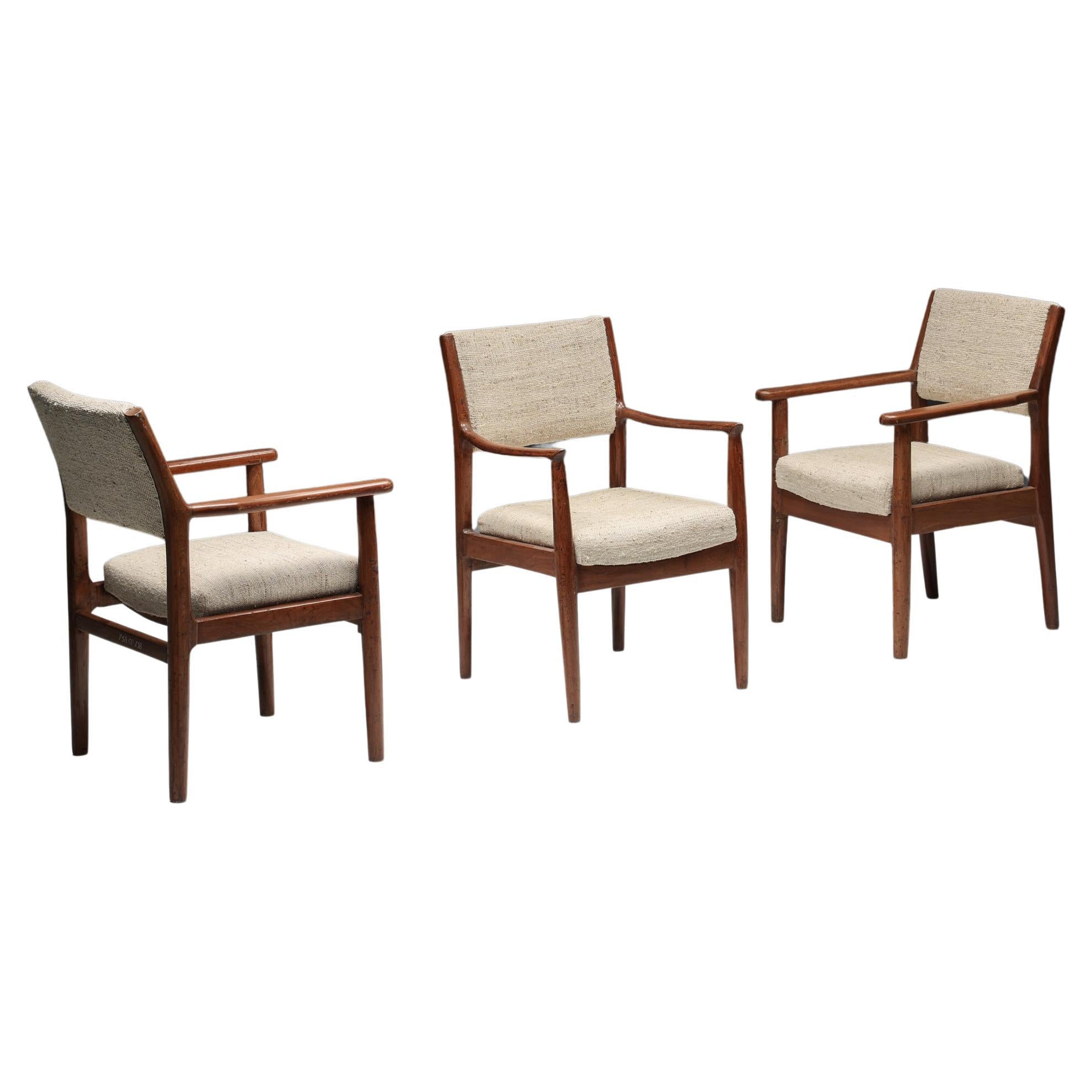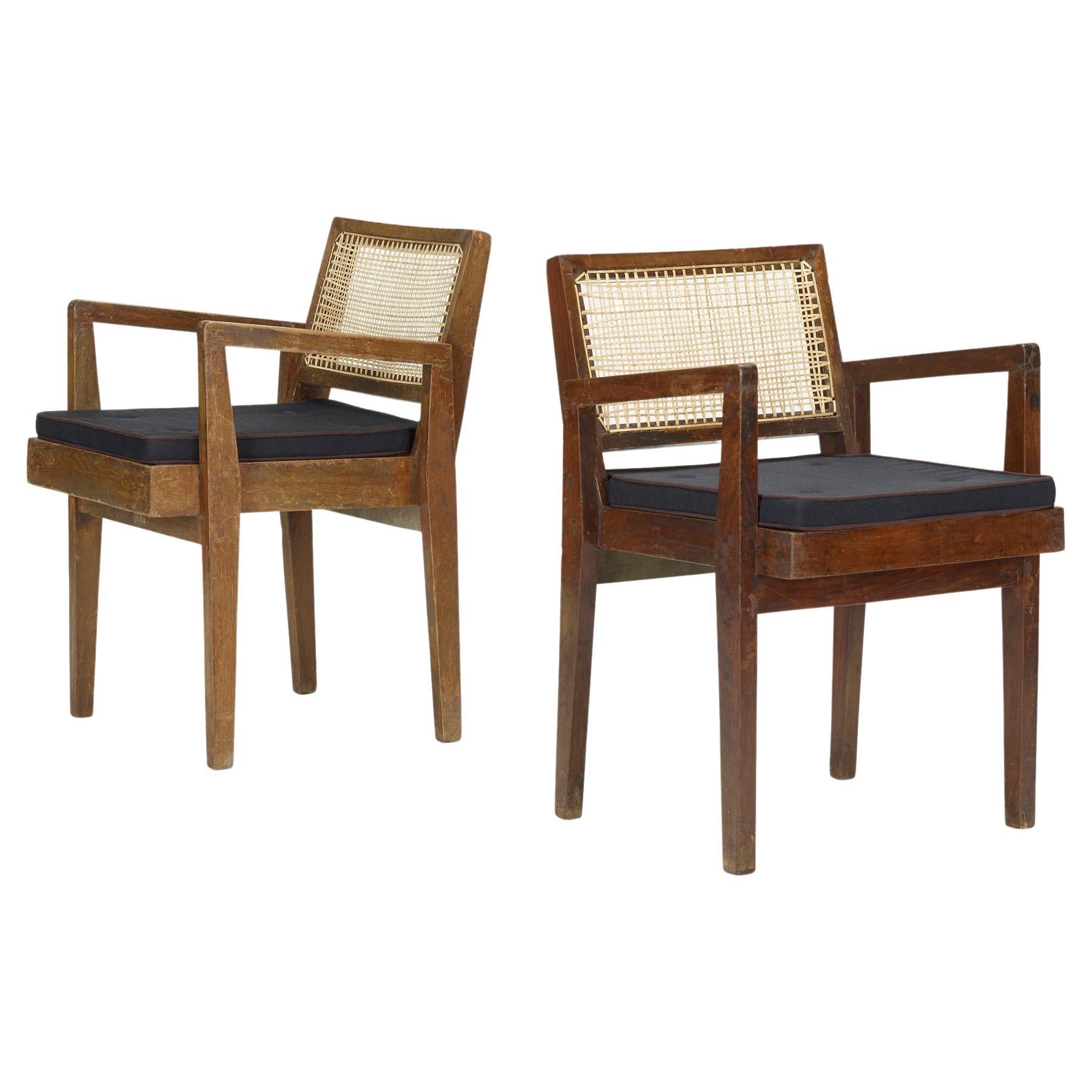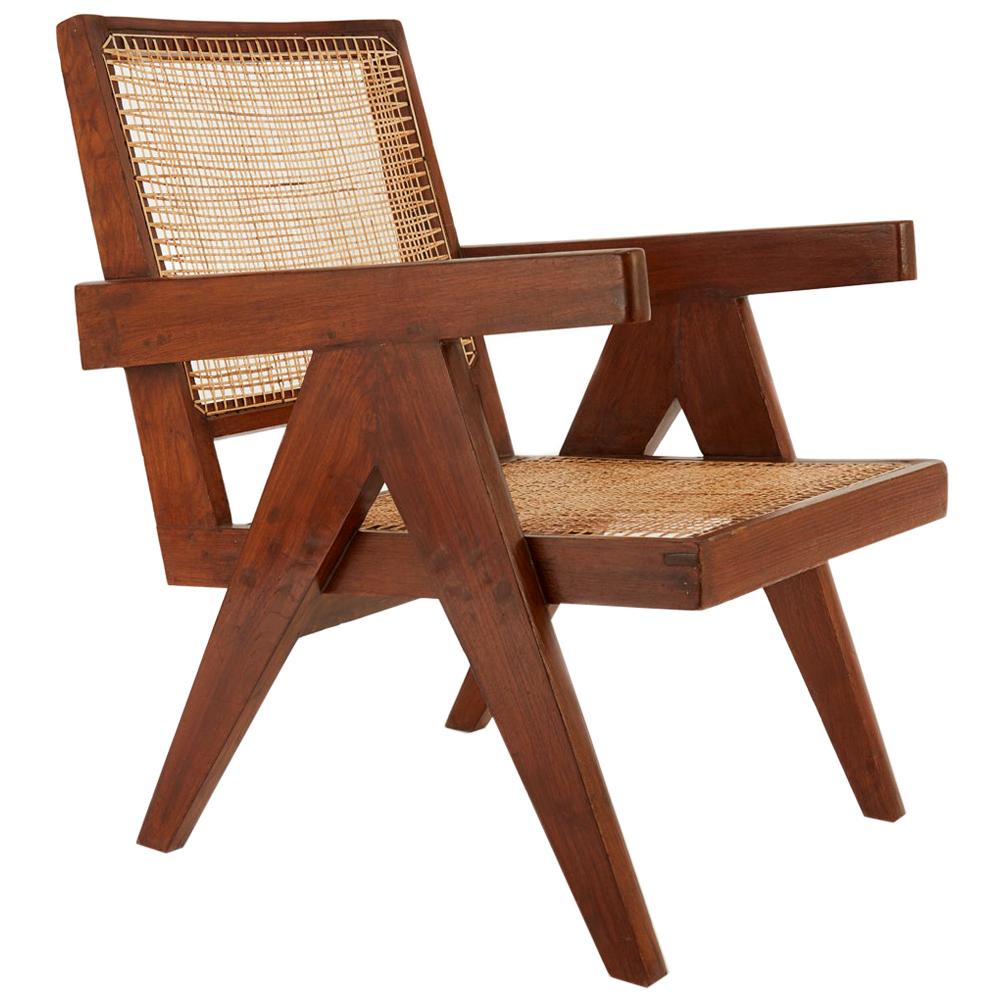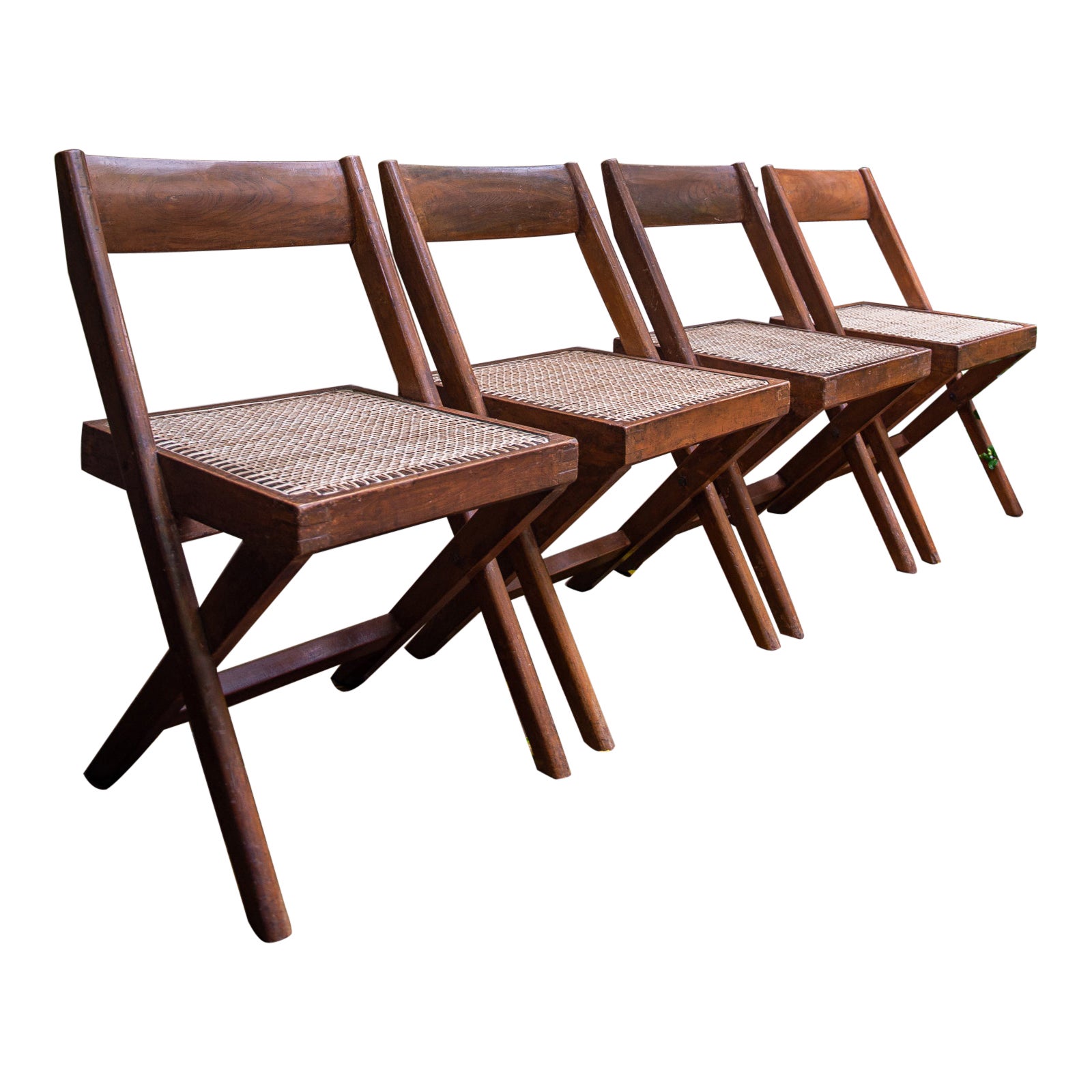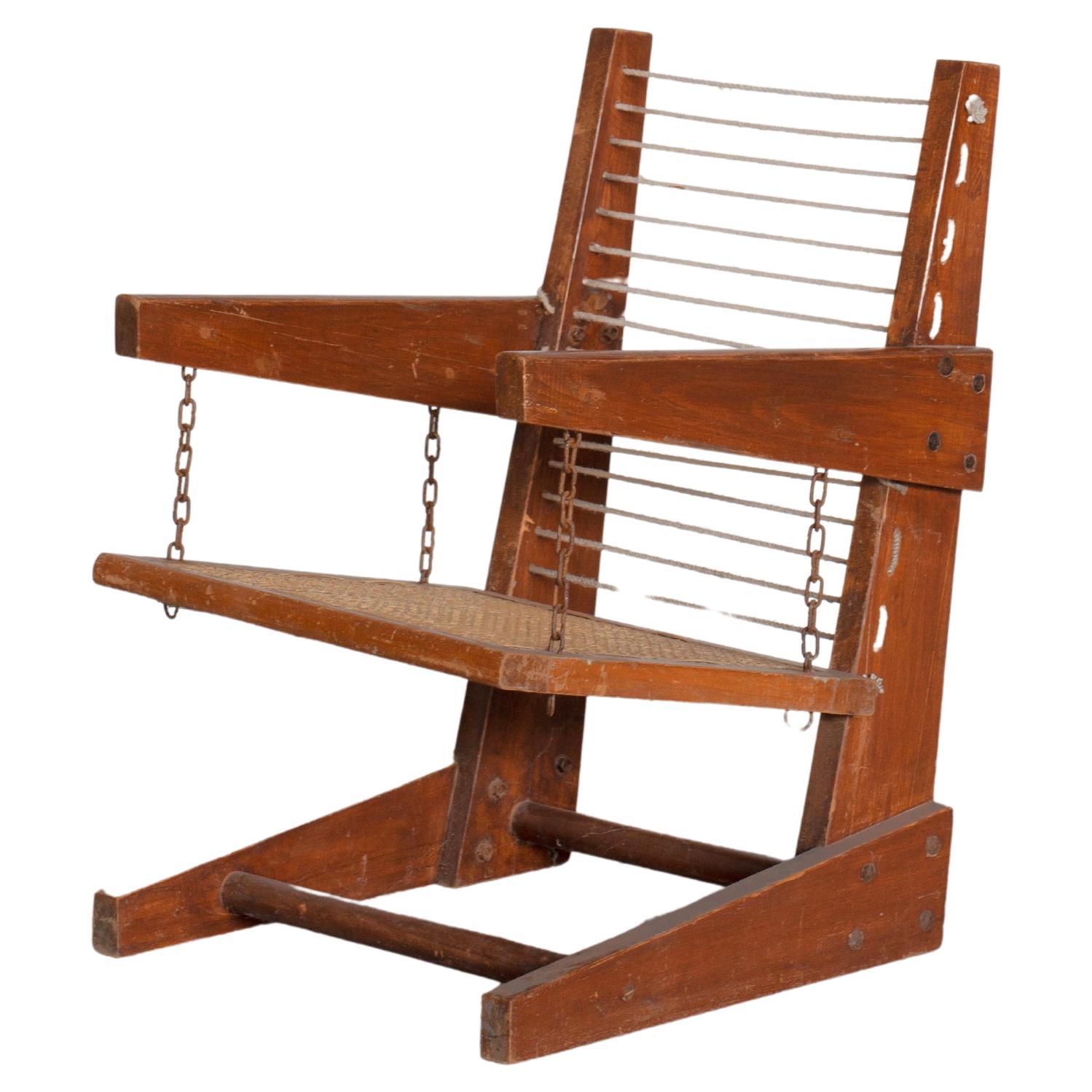Pierre Jeanneret 'Senat' Chair Designed for Chandigarh's High Court, 1959-60
About the Item
- Creator:Pierre Jeanneret (Designer)
- Dimensions:Height: 35.83 in (91 cm)Width: 23.23 in (59 cm)Depth: 25.4 in (64.5 cm)Seat Height: 20.48 in (52 cm)
- Style:Mid-Century Modern (Of the Period)
- Materials and Techniques:
- Place of Origin:
- Period:
- Date of Manufacture:1959-1960
- Condition:Wear consistent with age and use. Minor losses. Condition Good to fair, the Teak wood frame is in good condition and structurally strong , there is some surface wear to the wood commensurate with age and use, the upholstery requires complete renovation, a fine example ready for restoration.
- Seller Location:bergen op zoom, NL
- Reference Number:1stDibs: LU930125761702
Pierre Jeanneret
If his famed cousin and longtime colleague Charles-Édouard Jeanneret — better known as Le Corbusier — was the visionary, then Pierre Jeanneret was the member of the architecture and design team who got things done. In recent years, Jeanneret has emerged from Le Corbusier’s shadow, as collectors have discovered his simple and striking furniture creations.
Jeanneret studied at the École des Beaux-Arts in Geneva and after he graduated in 1921 he became a partner in Le Corbusier’s office in Paris. The pair collaborated on numerous residential projects, most notably the Villa Savoye, the iconic modernist house in suburban Paris completed in 1931. Jeanneret also worked with the great Charlotte Perriand on the Grand Modele line of tubular metal furnishings that was a sensation at the annual Salon d’Automne design expo in 1929. A rift developed between Jeanneret and his cousin during World War II, as the former joined the French resistance, while Le Corbusier cooperated with the occupying authorities in Vichy. The two did not work together again until 1950, when Le Corbusier persuaded Jeanneret to help execute the master plan for the new city of Chandigarh in Punjab, India. Jeanneret lived and worked there until the final years of his life.
A hallmark of Jeanneret’s furniture designs is his great sensitivity to materials. In contrast to the tubular-steel chairs produced by Marcel Breuer and other members of the Bauhaus, the chromed metal pieces designed by Jeanneret and Perriand — including such as the now-classic LC4 chaise longue and the Grand Confort lounge chair — have a sensuous, relaxed and welcoming look. Conversely, while Jeanneret uses essentially geometric forms for his wooden seating pieces, they exude warmth by nature of the material.
One of Jeanneret’s first manufactured designs in wood is the Model 92 Scissors chair, licensed by Hans and Florence Knoll when they were touring postwar France. But Jeanneret’s finest work in furniture was done in Chandigarh, and these are the pieces that have earned him recent renown. Crafted of teak, the designs range from low-slung lounge chairs and armchairs with cane seats to desks and tables, most with Jeanneret’s signature drafting compass-shaped legs. Many such pieces on the market today are refurbished, having been found by dealers languishing in scrapyards in India in the late 1990s. Chandigarh is now taking better care of its modernist heritage, making available Jeanneret works all the rarer.
Find authentic vintage Pierre Jeanneret chairs, tables and other furniture today on 1stDibs.
- ShippingRetrieving quote...Ships From: bergen op zoom, Netherlands
- Return PolicyA return for this item may be initiated within 7 days of delivery.
- Pair First Edition "Big Tulip" Lounge Chairs F551 by Pierre Paulin Artifort 1959By Artifort, Pierre PaulinLocated in bergen op zoom, NLVery rare pair of the first edition of the "Big Tulip" chair, model F551 Just Married! Designed by French designer Pierre Paulin in 1959 for Artifort, The Netherlands Reuph...Category
Vintage 1960s French Mid-Century Modern Lounge Chairs
MaterialsSteel, Nickel
- Pair of Raoul Guys 'Antony', Chairs Designed for Cite University, Paris , 1954By Raoul GuysLocated in bergen op zoom, NLRare and important pair of Raoul Guys 'Antony' chairs designed in 1954 for the world famous 'Cite' university's 'Jean Zay / Antony' residence 'in Paris . This stunning design was produced concurrently by 'Airborne' in France and 'Trefac' in Belgium (on official license) ' Beautiful sculptural form design with enameled steel rod frame and thermoformed plywood seat and backrests .both chairs are finished in their original faux leather fabric. A rare opportunity to acquire a pair complete with original upholstery, We can recover the chairs should we receive a request to do so. This pair were produced by 'Trefac' in Belgium , we found a 'Trefac' manufacturer's catalog dated 1957 which illustrates this model (please see image 6). 'Trefac' produced these chairs for the Belgian market under license from 'Airborne',France. The 'Jean Zay/ Antony' university residence was designed by the French architect Eugene Beaudoin and built in 1954. The interior furniture and lighting for the “Antony” residence was designed by the most influential of the group of “new” French designers , key figures such as Jean Prouve , Charlotte Perriand and Serge Mouille . Several of the chairs chosen for the ”Antony” building in Paris were designed by Raoul Guys including this design and his famous sculptural form wicker and steel lounge chair, please refer to images 2 and 3. These chairs were commissioned by the French government ,through the guidance of master French Sculptor and archtect , Andre Bloc, who greatly admired Guys' sculptural yet practical designs. Bloc was also involved in selecting furniture for the 'Cite' university's 'Maison Bresil' and 'Maison Mexique' university buildings in 1953 again furnished with designs by Jean Prouve , Charlotte Perriand and Serge Mouille among others. Bloc also advised 'Air France' to select Guys' 'oro' series of designs finished in bent steel and wicker for use in their 48 airports across the African continent ,they were famously used in the 'Brazzaville' complex of hotels and the Hotel N'Gor in Dakar again alongside furniture designed by Jean Prouve and Charlotte Perriand again selected by Andre Bloc. Please refer to the the last two images where you can see our collection of chairs that Raoul Guys designed for the 'Anthony' building in Paris and Air France's 'Brazzaville' complex and HotelT N'Gor in Dakar . Charles Bernard founded his company 'Airborne' in order to bring modern design to the population of France. Bernard asked his close friend and famous sculptor and architect Andre Bloc to seek out talented young designers who could produce furniture with an artistic or sculptural quality. Bloc was already working in this field with the “group espace” who saw art and sculpture as a social phenomena and aimed to bring art into the everyday living experience . For example it was Bloc who commissioned Charlotte Perriand to produce the famous 'Mexico' and 'Tunisie' bookcases for the Cité Internationale Universitaire , Paris for which Bloc also produced the colour scheme and he also worked closely with the Steph Simon gallery in Paris famous for showcasing the work of Prouve,Perriand and Noguchi among others. . Bloc had at this time recently come across a young designer Raoul Guys who’s work he greatly admired and which offered a sculptural quality to furniture design and asked him if he would like to collaborate with Airborne . In the book “les decorateurs des Annees 50” by Patrick Favardin it mentions that Andre Bloc presented Raoul Guys as a very interesting creator. Guy’s chairs had a suprising and sculptural quality in the free spirit of the after war period. LITERATURE: 'Airborne i945-75' ,page 35...Category
Vintage 1950s French Mid-Century Modern Chairs
MaterialsSteel
- Pair of Side Chairs by Judit Burian & Erika Szek Hungary, circa 1959By Judit Burian & Erika SzekLocated in bergen op zoom, NLPair of side chairs by Judit Burian & Erika Szek made in Hungary, circa 1959 Very much inspired by the works of Italian (Aug...Category
Vintage 1950s Hungarian Mid-Century Modern Side Chairs
MaterialsFaux Fur, Ash, Plywood
- Swiss Design Set of 4 Hans Bellmann 'GA' Dining Chairs for Horgen Glarus 1955By Hans Bellmann, Horgen-GlarusLocated in bergen op zoom, NLRare set of 4 original early production GA dining chairs by Swiss designer Hans bellmann produced by Horgen Glarus late 1950's Beautiful curved Teak plywood seating on a chromed me...Category
Vintage 1950s Swiss Mid-Century Modern Chairs
MaterialsMetal, Chrome
- Henk Stallinga 'One Nightstand' Chair Droog Design, The Netherlands, 1996By Henk StallingaLocated in bergen op zoom, NLThis unique pair of 'one nightstand' chairs comes from a private collection and only three were ever produced It was commissioned by the Aids Foundation in 1995 Henk Stallinga...Category
1990s Dutch Minimalist Chairs
MaterialsBirch, Plywood
- Pair of New Upholstered Lounge Chairs by Theo Ruth for Artifort 1950'sBy Artifort, Theo RuthLocated in bergen op zoom, NLPair of nicely curved wingback chairs in a senior and lady version by Dutch designer Their Ruth for Artifort manufactured in the 1950's Photo's of the complete classic reupholstery proces are featured in this listing showing the craftsmanship we put back in to restore these chairs as if they where made in the 1950's The Wool Boucle fabric is 'Monza' by Dutch manufacturer De Ploeg These chairs are made of solid Birch wood frames and a classic steel spring & stepped grass & cotton interior and will last another lifetime The sizes listed are for the senior version The lady chair...Category
Vintage 1950s Dutch Mid-Century Modern Lounge Chairs
MaterialsSteel
- Pierre Jeanneret Chandigarh PSA-CC°315/166 Armchair, Chandigarh, 1950sBy Pierre JeanneretLocated in Antwerp, BEPierre Jeanneret Chandigarh PSA-CC°315/166 Armchair, Chandigarh, India, 1952-1965 These armchairs by Pierre Jeanneret were created for the city of Chandigarh in India, the utopian...Category
Vintage 1950s Indian Mid-Century Modern Armchairs
MaterialsWood, Wool
- Pierre Jeanneret Armchairs from Chandigarh, pair, c. 1955By Pierre JeanneretLocated in New York, NYA pair of authentic arm chairs from Chandigarh deisgned by Pierre Jeanneret. Date of manufacture is between 1955-1960. These chairs are made of solid Burma teak with caned seats and ...Category
Vintage 1950s Indian Mid-Century Modern Armchairs
MaterialsCane, Teak
- Pierre Jeanneret X-Easy Armchair Authentic Mid-Century Modern ChandigarhBy Pierre JeanneretLocated in Zürich, CHThis chair is not only a fantastic piece, it’s a design icon. It is raw in its simplicity, embodying an expressing a nonchalance. There is something deeply relaxing about this design...Category
Vintage 1950s Indian Mid-Century Modern Armchairs
MaterialsTeak
- Pierre Jeanneret Easy ChairBy Pierre JeanneretLocated in Soho, London, GBIconic easy chair by Pierre Jeanneret from the administrative offices of Chandigarh, India. Restored and recaned in natural cane.Category
Mid-20th Century Indian Mid-Century Modern Chairs
MaterialsCane, Teak
- Four X Frame Chairs by Pierre Jeanneret & Eulie Chowdhury, Chandigarh India 1959By Pierre JeanneretLocated in London, GBChair known as ‘Cane seat wood back chair’ in solid teak and braided canework. Solid ‘banner’ type backrest, slanted and slightly curved. Canework seat and ‘X’ type double leg assembly, with the legs connected by a rail at the back. Provenance: University Library in Chandigarh. High Court in Chandigarh (2nd series of furniture in 1960). Ref: Swiss National Museum in Zurich. City Museum in Chandigarh. Similar model in the catalogue ‘Phillips - Design London Day Sale’. Sale on 28/04/2015, lot no 69. Set of six sold for £37 500 / €52 455. Ref: MARG magazine, ‘Chandigarh’, 1961. Photo ref: Similar model in ‘Le Corbusier, Pierre Jeanneret, Chandigarh, India’ by Galerie Patrick Seguin, pages 182, 183, 184, 185, 186, 219, 221, 250, 265, 283. Photo ref: Similar model in ‘Catalogue – Amie Siegel’ Ed Prem Krishnamurthy. Printed: die Keure 2014, pages 112, 136, 137. Photo ref: Similar model in ‘Le Corbusier Pierre Jeanneret l'Aventure Indienne’ by Eric Touchaleaume and Gérald Moreau, page 569 under reference: PJ-SI-51-A Chandigarh a short history: Upon the request of Prime Minister Nehru at the end of the 1940’s, Le Corbusier and Pierre Jeanneret, his cousin, were entrusted with an extraordinary project : the creation of the capital of Punjab, its urban scheme, its architecture and its furniture. Chandigarh’s furniture...Category
Vintage 1950s Indian Mid-Century Modern Dining Room Chairs
MaterialsCane, Teak
- Pierre Jeanneret PJ-SI-07-A Hanging Armchair/ Mid-Century Modern ChandigarhBy Pierre JeanneretLocated in Zürich, CHThis chair is a fantastic piece, finally it's iconic. It is raw in its simplicity, nothing too much but still nothing is missing. It is a chair with a very strong shape. In the big s...Category
Vintage 1950s Indian Mid-Century Modern Chairs
MaterialsMetal
Recently Viewed
View AllRead More
The 21 Most Popular Mid-Century Modern Chairs
You know the designs, now get the stories about how they came to be.
Vincent Van Duysen Imbues Minimalism with Warmth
The Antwerp-based designer lends his unique touch to homes, boutiques and offices in Belgium, the United States and Germany, as well as furniture for B&B Italia and Molteni.
